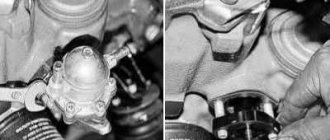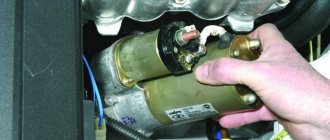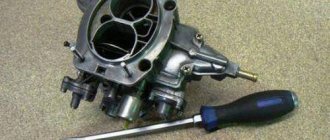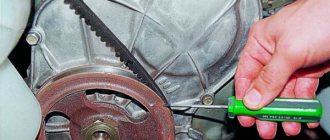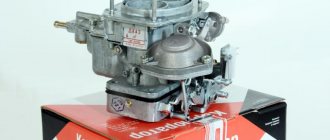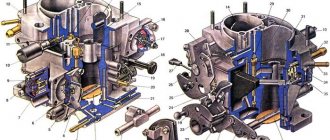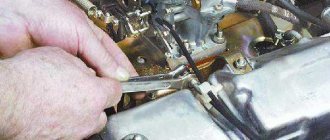Carburetor VAZ 2105
What is a carburetor and what are its functions? Today, carburetor modifications of vehicles are considered to be “outdated”, since they have been replaced by more “tenacious” injection ones.
However, in our country, carburetor versions of cars will be popular for a long time, since most AvtoVAZ cars are designed specifically on the basis of carburetor engines. Including the VAZ 2105 model, popularly called the “five”.
So, the carburetor is the most important mechanism in a car engine. Its main purpose is to prepare the fuel-air mixture and supply it to the engine cylinders. Simply put, a carburetor is needed to ensure that the engine receives fuel in the doses necessary for operation.
The air filter was removed for demonstration; the carburetor is located directly below the filter housing.
Carburetor design
The engines of the VAZ 2105 car are equipped with carburetors of type 2105–1107010. This number must be indicated on a black plate, which is attached to the cover of the carburetor itself.
The device has two chambers so that the processes of formation of the fuel-air mixture and its supply to the cylinders occur quickly and correctly. In fact, structurally, the carburetor has a huge number of small parts interconnected, but technically the device is not considered complex.
The cast body combines many small parts, each of which performs its own function
In order for the engine to operate in different modes (warm-up, idling, medium load and high speed), the carburetor consists of three main parts:
- The upper one consists of the device cover and fittings for fuel supply.
- The middle one is the carburetor body itself, which houses two internal combustion chambers and diffusers.
- Lower - includes the float chamber and throttle valves.
In the proper operation of the VAZ 2105 carburetor, small parts such as gaskets, springs or jets play a huge role. It is these parts that most often fail, which affects the operation of the engine.
Parts of the carburetor body 2107–1107010: 1 — rod of the pneumatic drive of the second throttle valve; 2 — pneumatic drive housing; 3 - diaphragm; 4 — pneumatic drive cover; 5 — fuel jet of the transition system of the second chamber; 6 — fuel nozzle body; 7 — small diffuser of the second chamber; 8 — accelerator pump nozzle; 9 — screw valve of the accelerator pump; 10 — main air jet of the second chamber; 11 — emulsion tube of the second chamber; 12 — main air jet of the first chamber; 13 — emulsion tube of the first chamber; 14 — main fuel jet of the second chamber; 15 — main fuel jet of the first chamber; 16 — accelerator pump adjusting screw; 17 — fuel jet of the idle system; 18 — fuel nozzle body; 19 — return spring of the accelerator pump; 20 — accelerator pump diaphragm; 21 — accelerator pump cover; 22 — small diffuser of the first chamber; 23 — lever return spring; 24 — three-arm air damper control lever; 25 — connection rod with the throttle valve; 26 — throttle valve return spring bracket
The essence of the operation of the carburetor unit on the VAZ 2105 comes down to the following processes:
- A strictly limited amount of gasoline enters the float chamber through a special valve.
- Fuel is directed through the jets to chamber No. 1.
- Here, gasoline is crushed into tiny pieces and mixed with parts of air.
- If the maximum amount of fuel is required (for example, during acceleration), then chamber No. 2 begins to work in the same way.
- After the fuel-air mixture is formed, the accelerator pump directs the fuel to the diffusers and then directly to the cylinders.
Carburetor calibration data
It should be noted that the carburetor type 21053 used for the VAZ 2105 is considered quite acceptable, despite the fact that it is usually used for VAZ engines with a volume of 1.2 liters, and the volume of the VAZ 2105 is 1.3 liters. Carburetor 2105 has the same design as 21053, but differs in calibration data. In other words, the carburetor circuit is almost identical. The difference can only be in the diameter, size, volume between the carburetor parts.
The main dosing systems include the diameter of the mixing chamber: the size of the first chamber is 28 mm, and the second is 32 mm, the diameter of the narrow part of the large diffuser with the size of the first chamber is 21 mm and the second is 25. This also includes the marking of the small diffuser with the corresponding chamber size 3 .5 and 4.5 mm, the diameter of the main fuel jet of the GDS with chamber sizes of 1.07 and 1.62 mm.
The main air jet of the GDS has chambers whose dimensions are the same and are 1.7 mm for both the first and the second. The transition and idle systems have a diameter of 0.5 mm for the idle fuel jet, 1.7 mm for the idle air jet for the first chambers, a diameter of 0.6 mm for the fuel jet for the transition system of the second chamber, and 0.6 mm for the air jet for the second transition system. cameras - 0.7 mm.
The acceleration pump has a diametral nozzle opening of 0.4 mm and a capacity with 10 presses equal to 7 + - 1.75 cm3. Econostats have fuel jets with a diameter of 1.5 mm, air jets with a diameter of 1.2 mm, and emulsion jets with a diameter of 1.5 mm. Characteristics of the pneumatic drive of the second chamber.
- The diametric value of the air jet of the first chamber is 1.2 mm, the second - 1 mm.
- The distance between the float and the cover gasket in the float chamber ranges from 6.5 + - 1/4 mm. The size of the full stroke of the float is 15 mm.
- Starting gaps have a throttle valve size of 0.07 to 0.08 mm, an air valve size of 5-5.5 mm. The air damper is controlled manually.
Carburetor 2105-1107010 has a remote pneumatic valve, but 2105-1107010-20 does not. In addition, carburetors 2105-1107010 and 2105-1107010-20 have a vacuum tap to the vacuum ignition timing regulator. Carburetor 21053 has slightly different parameters.
What carburetors are installed on the VAZ 2105
All carburetor installations equipped with the VAZ 2105 are focused, first of all, on minimizing fuel consumption. Of course, AvtoVAZ engineers throughout the history of the “five” experimented with the equipment of the car in order to identify the most effective mechanisms.
Over the years, various modifications of carburetors were installed on the VAZ 2105. All of them had both their advantages and disadvantages, which the drivers themselves often had to identify while driving.
Modification of DAAZ
The Dimitrovgrad Automobile Unit Plant (DAAZ) has launched the production of carburetor units under license from Weber. The main quality of DAAZ products is ease of operation and repair. The production of all parts necessary for repair and replacement was established, so if necessary, the driver could easily buy the necessary components and independently carry out the work of adjusting the carburetor.
DAAZ carburetors provided the car with increased speed characteristics, since the new nozzle system made it possible to react as quickly as possible to an increase in speed and supply the required amount of fuel to the engine.
A significant drawback of the Dimitrovgrad Automotive Unit Plant carburetor can be considered fuel consumption. In the combined cycle, the device required at least 10–14 liters of fuel per 100 kilometers.
There are no cons. The DAAZ 2105 carburetor is an excellent thing. The machine does not leak or overflow, the consumption is normal... Thanks to the manufacturer for such an excellent product. We will use your services and recommend you to friends.
Gosha 5410
https://otzovik.com/review_2963738.html
The first VAZ 2105 cars were equipped with DAAZ carburetors
Modification "Ozone"
The Ozone carburetor is considered a modified version of the device that was assembled at DAAZ under license from Weber. "Ozone" is a more advanced version of the old "DAAZ". This carburetor has higher environmental friendliness, and also significantly reduces fuel consumption per 100 kilometers.
However, not everything is so good in the Ozone design. After numerous complaints from VAZ 2105 drivers, the designers identified a major drawback of this type of carburetor. The device is equipped with two chambers, but a pneumatic valve takes part in the operation of the second chamber. It was because of this that drivers had problems, since even with the slightest contamination the valve began to work incorrectly.
I have an Ozone 2105 with a mechanical drive for the shutter of the second chamber, the calibrations are standard. I tried installing jets of increased diameter - it seemed to me that the flow rate increased noticeably, but the dynamics were not much

